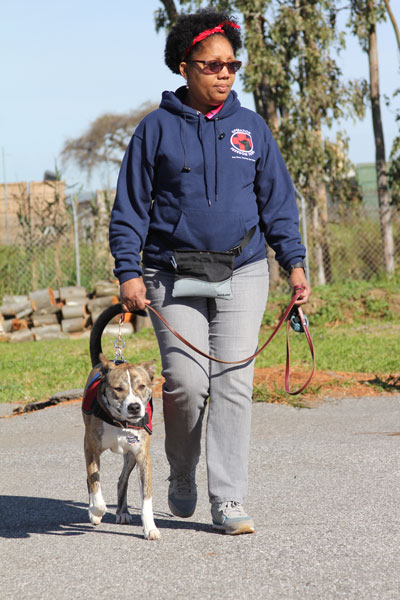Help protect your pet by always keeping them on leash

By Dr. Jeanne Haggerty-Arcay

Dr. Jeanne Haggerty-Arcay
The past few months have brought unprecedented times to the country and the world. With everyone staying at home in Morgan Hill, social distancing and trying to stay safe, our everyday lives have changed. Many are working from home, kids have been attending web based classrooms from home and everyone is spending much more time outside. Life for our dogs has changed dramatically as well and as pet owners we will all have to keep them in mind with our changing lifestyle.
Hiking has become the newest trend in entertainment. Many people are out more than ever walking their dogs. For the most part, it is fantastic for everyone, but those who are not used to this lifestyle can run into trouble.
Foxtails: Foxtails are small, barbed weeds that dry out in the summer and wreak havoc on our pets. They readily burrow into feet, ears, eyes, noses, etc. They are prevalent on all the bay area trails, whether you are on a paved trail or venturing off.
Help protect our pet by always keeping them on leash, tracking down the middle of the trail rather than along the edges where they will encounter brush and doing foxtail checks after each visit to the trail.
Dogs with long, sticky coats (poodles, labradoodles, etc) should not be out on the trail as these types of coat tend to attract the foxtails more readily. If you have a pet that tends to attract foxtails and you want to take them, have their feet and coat trimmed very short so you can more easily perform proper foxtail checks.
Masks: Although masks are nothing more than a simple annoyance for most people, for some dogs they can be absolutely terrifying. Imagine if all the sudden the way all people outside the house looked different and scary? Many dogs do not understand and those that are already easily spooked can become very scared or even aggressive. Remember to reassure them and use positive reinforcement if they are showing skepticism.
 Flexi Leashes: Stick to a standard six-foot leash. It provides much better control. Your dog may be used to being walked, but the aggressive 100-pound dog passing you may only be out walking because their owner is working from home. Remember that social distancing also applies to dogs and you want to keep them close by your side.
Flexi Leashes: Stick to a standard six-foot leash. It provides much better control. Your dog may be used to being walked, but the aggressive 100-pound dog passing you may only be out walking because their owner is working from home. Remember that social distancing also applies to dogs and you want to keep them close by your side.
Heat: During these warmer and downright hot months, the heat can be problematic. A warm, but doable 80 degree run for a human is too warm for a dog, especially if they have not been groomed and are sporting a long coat.
Also, keep in mind that concrete gets very warm. Skin destruction can begin at temperatures of 125 degrees, which correlates to air temperatures of 77 degrees. At 86 degrees, the asphalt would be 135 degrees. If you cannot comfortably press your hand against the asphalt for 7-10 seconds, then it is too warm.
Weekend Warrior Syndrome: You may have been used to going to Crossfit every morning prior to the pandemic and have now replaced it with running with your dog . . . but did your dog go to Crossfit?
We all enjoy the company of our dog when running but keep in mind that their level of fitness may not be the same as yours.
 Don’t ask them to do more than they are fit to do as most dogs are pleasers and will keep going well past their point of exertion.
Don’t ask them to do more than they are fit to do as most dogs are pleasers and will keep going well past their point of exertion.
Traveling Around Town: Although many dogs do like to drive around in the car, consider that your dog may be happier staying at home in the air conditioning.
At temperatures of 85 degrees, it only takes 10 minutes for the inside of your car to reach 102 degrees. Parking in the shade and cracking the windows will be of little benefit. Remember that older, overweight, short-nosed, thick/long-coated and unhealthy dogs will be even more susceptible to heat stroke.
Separation Anxiety: Everyone has been spending more time with their pet during the pandemic. But can too much time be bad?
Some dogs, especially those who are very clingy or already predisposed to be anxious will develop separation anxiety.
This is a very common disorder where a pet becomes codependent on their owner and is no longer able to stay alone comfortably without self-destructive behavior or excessive anxiety.
This is often seen after people who are normally working are all the sudden home for extended periods. Then when the schedule returns to normal, the pet has lost the confidence and ability to be alone. Prevent this by making sure that your pet spends time alone.
Do not take your pet on every errand or let them sit on your lap all day long while you Zoom. Returning to life as it was will be hard for some dogs so make sure you force them to spend some time alone so they do not lose that ability.
Enjoy this extra time with your pet. But stay safe, stay cool and keep your distance.






